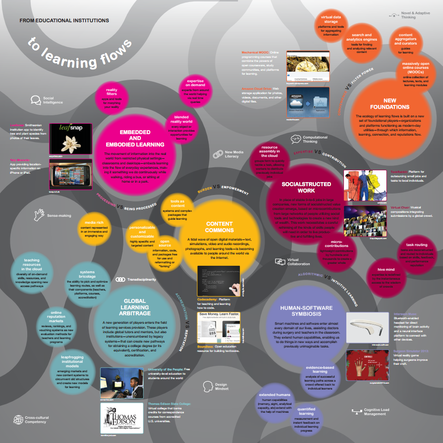Future Now
The IFTF Blog
Future of Learning: From Assigning to Enticing with Content
Finally, disruption has come to education. Many would agree it’s been too long in coming. Now, the same forces that have disrupted every other sector of society–manufacturing, business, health care, entertainment, to name a few–are challenging education’s old habits. The amazing thing is how robust the model of the conventional classroom has been, dating back centuries to the founding of the university and the one-to-many lecture that still reigns as the primary teaching method in many colleges and schools.
But now, the Internet and its multimedia have made the world of information available 24/7 to every student with a smartphone, for free. The recent pace of new devices and marvelous content, from the Art Project by Google’s tour of the world’s greatest art museums to Khan Academy, has been astonishing. If information is power, then, for the first time in history, it is now in the hands of students.
This dramatic shift will change everything about education as we have known it. Enter IFTF's newest map, Future of Learning: From Educational Institutions to Learning Flows. That title captures the shift, that schools and universities will no longer be the sole source of delivering and accrediting learning. Now, learners are designing their own “learning flows” that take them in and out of a variety of learning experiences and places, including but not limited to classrooms, and taking advantage of opportunities outside the classroom and online. These other “learning spaces” can include the science centers, art and history museums, and libraries that have played important roles for decades, but also new “Maker Spaces” offering labs and equipment to any one of any age who walks in the door.
The map describes moving from “from episodic to continuous learning.” Mobile media enable us to learn while we’re on the move, even while walking down the street, using one of my favorite apps, Leafsnap from the Smithsonian. Wonder about the name of that tree or flower? Take a snapshot of its leaf or petals, and Leafsnap tells you all about it. Perhaps now, we can regain that curiosity we had as children and develop “continuous curiosity.”
I especially like another key shift: “from assigning to enticing with content.” Have the words “education” and “enticing” ever been used in the same sentence before? We are already seeing that learners are being drawn to new types of learning experiences and incentives offered, for instance, through Mozilla Open Badges. Instead of forcing students to learn a set curriculum, wringing out hands when they don’t, and wasting enormous sums of taxpayer dollars in the process, is it possible that, given an enormous range of learning choices, they might voluntarily flock to topics they’re passionate about?
This map is a rich provocation for everyone with an interest in creating the brave, new world of learning, in schools, higher education, companies, government agencies, and foundations. It can be a guide to a new education landscape that is bigger and better, more exciting, and even enticing, than we thought.
Download
A free PDF of the Future of Learning: From Educational Institutions to Learning Flows map is now available for download.
 Milton Chen was a member of IFTF's inaugural class of Future for Good Fellows. The Future for Good Fellowship Program is an IFTF initiative to create visions and develop actions for our collective good.
Milton Chen was a member of IFTF's inaugural class of Future for Good Fellows. The Future for Good Fellowship Program is an IFTF initiative to create visions and develop actions for our collective good.




